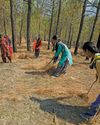
FOR THE past seven years, Raizul Mondal and several other residents of Jalangi village in West Bengal's Murshidabad district have been guarding India's eastern borders. They have even sacrificed their livelihoods to prevent a catastrophe. Lurking across the international boundary in Bangladesh is an invisible enemy-Magnaporthe oryzae Triticum (MOT), a fungus that attacks wheat crops and can wipe out the entire harvest in a matter of days.
Before reaching Bangladesh in February 2016, the fungus had periodically ravaged 3 million hectares (ha) of wheat fields in South America since it was first identified in Brazil in 1985. An outbreak in 2009 had cost Brazil one-third of that year's crop. The 2016 outbreak in Bangladesh-this is when the fungus made its first appearance in Asia was equally rapid and devastating.
Estimates by the country's Department of Agricultural Extension show that the fungus caused wheat blast disease in 15,000 ha-3.4 per cent of the area under the crop in Bangladesh-reducing yield by 51 per cent in the affected fields. Since then, MOT has spread to 14 districts, including Jashore, Jhenaidah, Chadanga and Rajshahi that border India. By 2018, the fungus invaded Africa and wheat blast appeared in experimental plots and farms of Zambia.
With its presence simultaneously on three continents, MOT has emerged as a global threat to food security. The fungus' presence in South America could derail the efforts by Brazil and Argentina to tackle the global wheat supply shortage caused by Russia's invasion of Ukraine, while its arrival in Zambia has put southern Africa's wheat-producing countries at risk. In Asia, the Bangladesh outbreak is a grave concern as India and China are global leaders in wheat production.
This story is from the June 16, 2024 edition of Down To Earth.
Start your 7-day Magzter GOLD free trial to access thousands of curated premium stories, and 9,000+ magazines and newspapers.
Already a subscriber ? Sign In
This story is from the June 16, 2024 edition of Down To Earth.
Start your 7-day Magzter GOLD free trial to access thousands of curated premium stories, and 9,000+ magazines and newspapers.
Already a subscriber? Sign In

THE CIRCULARITY ARGUMENT
A circular economy can help India achieve its developmental aspirations while following the low-carbon pathway. It will also help address the challenges of waste management, pollution and overexploitation of natural resources. Industries are already innovating to reuse high-volume wastes and have shown that the transition can usher in both environmental and financial windfalls

Banking on flawed drug voluntary licences
The Medicines Patent Pool is pushing for more VLs, but its bad deal with Novartis on a cancer drug shows the pitfalls

Lasting solutions
For the first time, the UN has recognised the role of indigenous communities in tackling aridity. A repository of traditional knowledge India has the wherewithal to lead the way

IMD at 150
India's journey into modern weather forecasting took a decisive turn 150 years ago with the establishment of India Meteorological Department during the British rule. The agency has come a long way since then, shaping the way the country predicts and responds to its diverse climate challenges

Every drop counts
In drought-prone Marathwada region, 14 villages have managed to counter water shortage by budgeting the resource

Threat to survival
Hollongapar Gibbon Sanctuary in Assam faces ecological challenges as railway electrification and hydrocarbon exploration endanger its fragile biodiversity

'Migration is going to be a battlefield'
AMITAV GHOSH is one of the foremost chroniclers of our times. His literary sojourn includes writings on topics that range from languages to climate change to human lives. His latest book, Wild Fictions, brings some of his works on these issues under one title. In a conversation with RAJAT GHAI, Ghosh shares his views on the future of human movement. Excerpts:

Face of future
California wildfires confirm forest fires are intensifying in a hotter world, emitting substantial amounts of greenhouse gases and reinforcing global warming

Friends of the forest
Residents of 30 villages in Uttarakhand establish a model for public participation in saving forests from wildfires

Climate-crazy playbook
Just hours after his second (and final) term began on January 20, US President Donald Trump unleashed 46 presidential actions. Several of these are centred on the US' climate commitments, energy transition, migration and trade policies, and are likely to have negative global implications